Hack:
A natural and flexible “three-tier management”
Based on the internal logic of human nature throughout the whole history of management thought, I can prove a natural and flexible “three-tier management”, and at the same time make a roadmap of connection among thought leaders like Ernst Engel, Abraham Maslow, Clayton Alderfer, Frederick Taylor, Henri Fayol, Elton Mayo, Douglas McGregor, and Joseph Schumpeter.
There are some differences between theory X and theory Y and three-tier management.
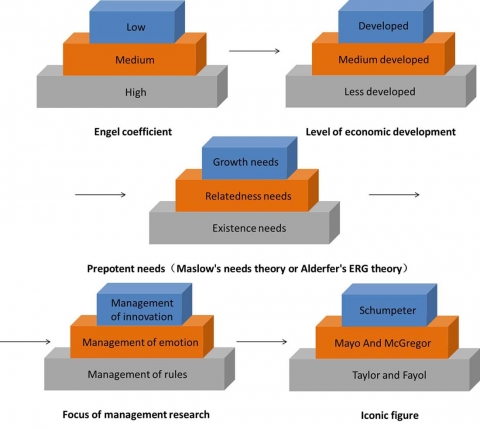
How to meet effectively and efficiently employees’ needs from the perspective of management model or system?
Natural and flexible human nature
What is the natural human nature (and by natural, I mean the human nature is not influenced by culture, religion and so on)?
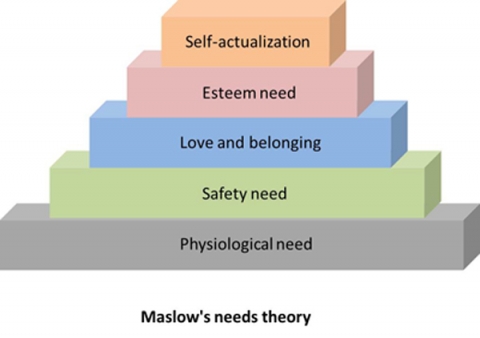
Here the natural human nature basically refers to Maslow‘s hierarchy of needs theory (HoN), or Alderfer's Existence, Relatedness and Growth Theory (ERG). In ERG, Alderfer compressed Maslow's HoN from five to three. For the sake of convenience, I adopt the latter.
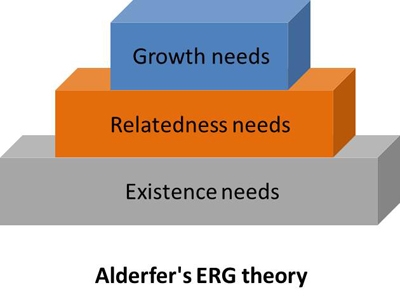
I think the natural human nature has four key points as follows:
1 Every human has three types of needs, namely, existence needs, relatedness needs, and growth needs.
2 There is a bottom-up hierarchical order among three types of needs above, from existence needs to relatedness needs to growth needs.
The bottom-up hierarchical order implies that the higher tier needs cannot be satisfied unless the lower tier needs have been met, especially two different needs were in conflict, that the higher tier needs is bigger in terms of their importance for career advancement than the lower one, and that to satisfy lower tier needs is easier than to satisfy higher tier needs.
3 Three tiers of needs are an indivisible whole and coexist with every employee at any time. One of three tiers of needs alone—whether existence needs, or relatedness needs, or growth needs—will not be able to bring high degree of satisfaction to employees. Only the smooth integration of three tiers of needs can do so
4 At any given time, every employee has a prepotent need that has the greatest influence over his or her actions, and that will vary among individuals.
The differences between theory X and theory Y and three-tier management
What is the flexible human nature?
In contrast to the natural or original, apparently, the flexible means the human nature is influenced by culture, religion, and so forth.
In different culture, religion, or ideology, employees with the same identity would have different order of needs and prepotent needs. For example, a low income worker who focused on existence needs in one kind of cultural background may focus on growth needs in another kind of cultural background.
From this perspective, employee needs are complex and multi-faceted.
Natural and flexible “three-tier management”
What is the natural or original “three-tier management”?
The natural or original “three-tier management” is corresponding to the natural or original human nature, that is, Maslow's hierarchy of needs, or Alderfer's ERG theory.
While there are some debates and criticism about Maslow's hierarchy of needs, or Alderfer's ERG theory, scholars and practitioners all agree that the fulfillment of human needs has an important role in human motivation.
How to meet effectively and efficiently employees’ needs based on the natural human nature from the perspective of management model or system?
I think the best way to do it is three-tier management.
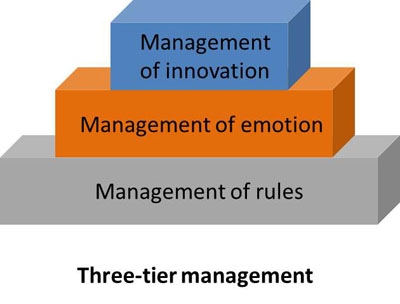
What are three tiers of managements? They are respectively management of rules, management of emotions, and management of innovations.
What is three-tier management? It is the integration of three tiers of managements.
First, I adopt management of rules in three-tier management to satisfy employees’ existence needs.

Because the rules here mean all rigidities for forming business organizations, including organizational structures, departmental responsibilities, job descriptions, levels of power and command, work standards, regulations and procedures, guideline, etc, the main purpose of aforesaid management of rules will be to establish a high-efficiency business organization or to continuously improve workforce productivity. And then a high-efficiency business organization with an appropriate income distribution mechanism can increase employees’ salaries sharply.
As we all know, in a work context, employees’ existence needs are usually satisfied by money earned in a job for the purchase of necessities of life.
Second, I adopt management of emotions in three-tier management to satisfy employees’ relatedness needs.

As the name implies, the main purpose of aforesaid management of emotions is to help employees cultivate positive emotions and healthy relationships with colleagues and managers, rules, and business organization.
Certainly, as companies realize the purpose of management of emotions, employees’ relatedness needs would be perfectly fulfilled.
Third, I adopt management of innovations in three-tier management to satisfy employees’ growth needs.

In my view, so-called growth should mean that employees can constantly gain new knowledge, new experiences, new opportunities, new challenges, new jobs, new achievements, and new satisfactions. In short, it can be equal to innovation from individual perspective.
So an excellent management of innovations, undoubtedly, will sufficiently satisfy employees’ growth needs.
Fourth, I adopt the smooth integration of three tiers of managements to satisfy all employees’ needs.
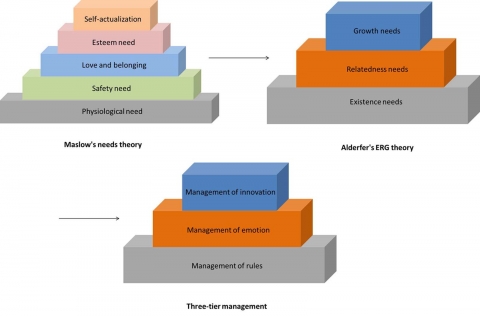
“Smooth integration” at least indicates that on the one hand, three tiers of managements form an indivisible whole. Each company and each employee, at any given time, needs all three tiers of managements. On the other hand, because different employee is focused on different tier of needs that is his or her precedence, different company should be focused on different tier of managements which is its priority. That is to say, if there is a majority of employees, in one low-end manufacturing company, focused on existence needs, management of rules should dominate such companies’ three-tier management. In other words, both management of emotions and management of innovations should comply or match with management of rules being priority
Similarly, if there is a majority of employees, in one financial services company, focused on relatedness needs, management of emotions should dominate such companies’ three-tier management. In other words, both management of rules and management of innovations should comply or match with management of emotions being priority
If there is a majority of employees, in one high-tech company, focused on growth needs, management of innovations should dominate such companies’ three-tier management. In other words, both management of rules and management of emotions should comply or match with management of innovations being priority.
What is the flexible“three-tier management”?
The flexible“three-tier management” is corresponding to the flexible human nature.
In different culture (including corporate culture), employees receiving the same compensation would have different order of needs and prepotent needs, and should be dominated by different tier of managements. For example, a low income worker who was dominated by management of rules in one corporate culture may be dominated by management of innovations in another corporate culture.
For a more efficient three-tier management, managers must be aware of all employees’ needs and understand which needs are crucial to them. And then managers know how to meet these needs with “the smooth integration of three tiers of managements”.
Natural and flexible history of three-tier management
What is the natural history of three-tier management?
The natural history of three-tier management is corresponding to the market economy under the condition of natural growth, such as Britain and he United States.
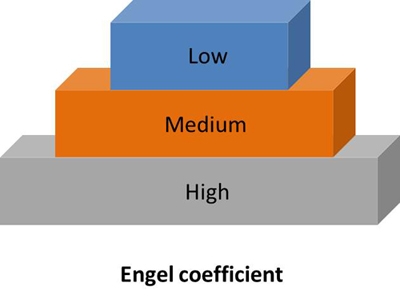
Based on the internal logic of human nature throughout the whole history of management thought and Engel’s law used as an indicator of living standards, I can make a roadmap of connection among thought leaders relevant to management like Ernst Engel, Abraham Maslow, Clayton Alderfer, Frederick Taylor, Henri Fayol, Elton Mayo, Douglas McGregor, and Joseph Schumpeter.
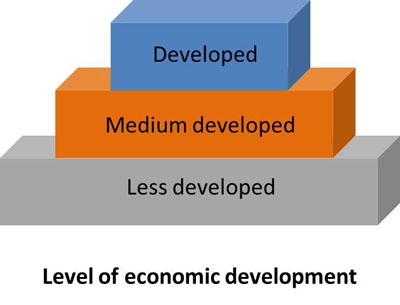
As Engel coefficient was high, it meant poorer or low level of economic development. It also implied that people’s prepotent need was existence needs, and that companies and management researches were focused on management of rules, namely, on how to establish a high-efficiency business organization or to continuously improve workforce productivity. At that time, the classic works were Taylor's "Principles of Scientific Management", and Fayol's "general and industrial management".
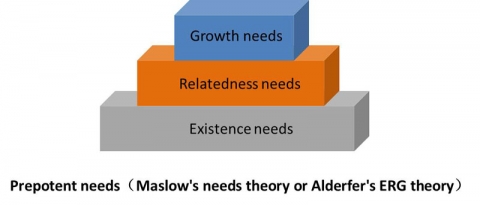
As Engel coefficient was medium, it meant medium level of economic development or medium standard of living. It also implied that people’s prepotent need was relatedness needs, and that companies and management research were focused on management of emotions, namely, on how to help employees cultivate positive emotions and healthy relationships with colleagues and managers, rules, and business organization. At that time, the classic works were Mayo's "The human problems of an industrial civilization", and Douglas McGregor's "X theory - Y theory".
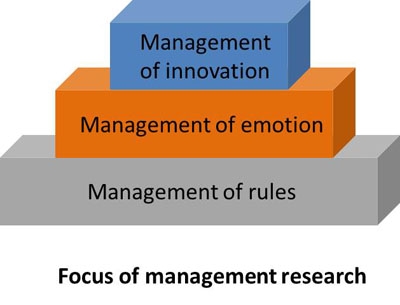
As Engel coefficient was low, it meant rich or high level of economic development. It also implied that people’s prepotent need was growth needs, and that companies and management researches were focused on management of innovations, namely, on how to help people constantly gain new knowledge, new experiences, new opportunities, new challenges, new jobs, new achievements, and new satisfactions. At that time, the classic works were about Schumpeter's "Theory of Economic Development".
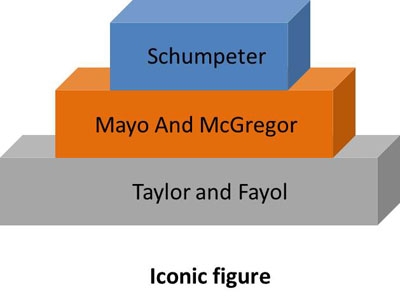
Engel coefficient in developed market economics has been declining from high to middle to low. The level of economic development has been rising from low to middle to high. The people's prepotent need has also been shifting from existence to relatedness to growth. The focus of management research has been moved up to management of emotions, to management of innovations from management of rules, step by step. Ultimately, the natural history of three-tier management is formed.
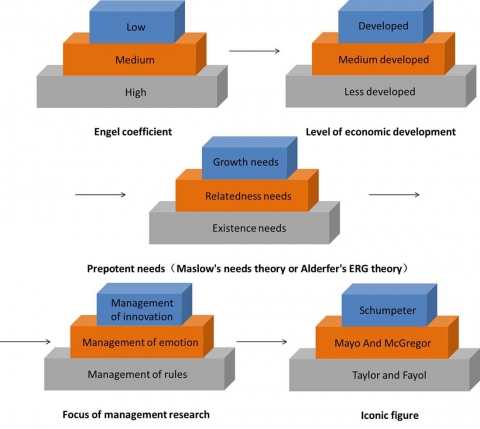
What is the flexible history of three-tier management?
The flexible history of three-tier management is corresponding to the market economy under the condition of non-natural growth, such as China and Russia.
The differences between theory X and theory Y and three-tier management
McGregor's theory was also based on Maslow's hierarchy of needs. He grouped Maslow's hierarchy into "lower order" (theory X) needs and "higher order" (theory Y) needs. He suggested that management could use either set of needs to motivate employees but that better results could be obtained by meeting the theory Y needs
In contrast to McGregor, I emphasize:
1 Maslow's five tiers of needs are an indivisible whole. One of five tiers of needs alone—whether physiological, or safety, or love and belonging, or esteem, or self-actualization—will not be able to bring high degree of satisfaction to employees. Only the smooth integration of five tiers of needs can do so.
2 At any given time, every employee has a prepotent need that has the greatest influence over his or her actions, and that will vary among individuals.
3 Three tiers of managements form an indivisible whole. Each company and each employee, at any given time, needs all three tiers of managements.
4 Each company, at any given time, should take one of three tiers of managements as its priority. Meanwhile, two other tiers of managements should comply or match with that priority.



You need to register in order to submit a comment.